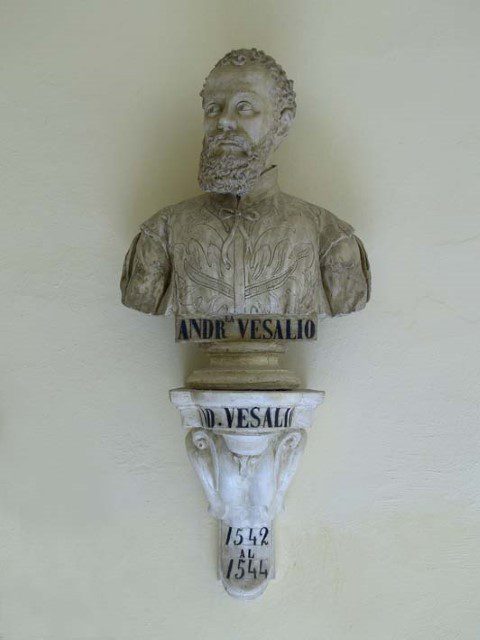Gianfranco Natale
Rosalba Ciranni
Paola Lenzi
Pisa, Italy

Andreas Vesalius was born in 1514 in Bruxelles and studied in Paris but graduated in Padua. He published De humani corporis fabrica in 1543, and then spent time conducting anatomical dissections in Bologna, Pisa, and Florence before becoming the private physician of Emperor Charles V.
The present note aims to look at the period he stayed in Pisa, where he was invited by the Grand Duke Cosimo I de’ Medici. We learn much from the studies by Corsini,1 O’Malley,2 and Ciranni,3 as well as from Vesalius’ Epistola [. . .] rationem modumque propinandi radicis Chynae decocti, quo nuper inuictissimus Carolus V imperator usus est. Vesalius worked in the Nuovo Studio Pisano, carrying out public dissections, discussing and refuting most of the Galen’s doctrine. In his Epistola he mentions his Pisan journey, but unfortunately provides no information about the reasons for his visit or its duration. Different objects found in Pisa, such as the Vesalius’ plaster bust (see figure), a marble epigraph located in the Scuola Medica, and a second marble epigraph on the first Pisan anatomical theatre, also lead to conflicting dates. But some of these discrepancies can be resolved by documents from Statuti of Pisa, as well as by fragments of three letters exchanged between the secretaries of Cosimo I, and by Cosimo’s letters to the Emperor Charles V in which he requests the emperor to allow Vesalius to stay longer in Pisa. The first secretary’s letter, dated January 22, 1543, concerns the public dissection made by Vesalius and reports the request that two corpses enclosed in coffins be sent by boat from Florence to Pisa. These letters are dated January-February 1543, corresponding to 1544 in the Florentine calendar.
From these letters it can be deduced that Vesalius wanted to carry out more dissections of humans and animals (di più d’omini come di altri animali) in Pisa. In his Epistola he considered Pisa a very important university, where he wanted to dissect corpses in order to study the skeleton. He was able to dissect two female corpses, a nun and a deformed woman, very interesting for an anatomist who had worked mainly with the corpses of male convicts. He also dissected a third corpse, that of Marcantonio Bellarmati, a reader in civil law, giving a detailed account of this autopsy in his Epistola. In the third letter dated, February 11, 1543 (1544), Vesalius is described as the best of anatomists. Cosimo I was an open-minded and enlightened person, intrigued by the possibility that dissection allowed one to study the structure of the human body. He offered Vesalius an annual salary to study and teach anatomy in Pisa, but Vesalius refused. Thus the University of Pisa remained without an anatomy teacher until October 1545, probably because of Vesalius’ refusal, as reported in two Grand Duke’s letters addressed to his ambassador to Charles V in which he asked the emperor to allow Vesalius to teach anatomy in Pisa. Evidently Charles V refused, and Cosimo hastened to apologize. But Vesalius did not find a conducive atmosphere at the Spanish court; it certainly was not as enlightened as the Medici court.
In conclusion, Vesalius stayed in Pisa for no more than three winter weeks at the beginning of 1544. During this time he taught anatomy and dissected human corpses without an annual salary. Indeed, la funzione della nothomia was traditionally practiced by a surgeon once a year in winter and usually during the carnival, when the coldest period allowed a better preservation of the corpses. Accordingly, the students could also participate in the dissection since the university was closed for the carnival holidays. Because of Vesalius’ refusal to accept a salary and Charles’ unwillingness to release him, Vesalius never became Lettore of anatomy in Pisa.
Notes
- Corsini, Andrea. Andrea Vesalio nello Studio di Pisa. Siena, Stab. Tip. S. Bernardino. 1915.
- O’Malley, Charles Donald. Andreas Vesalius of Brussels 1514-1564. Berkeley and Los Angeles, University of California Press, 1964.
- Ciranni, Rosalba. “Andrea Vesalio a Pisa.” Medicina nei secoli, vol. 22, n. 1-3, 2010.
GIANFRANCO NATALE, MD, is director of the Museum of Human Anatomy “Filippo Civinini” and associate professor of human anatomy at the University of Pisa. He teaches human anatomy at the School of Medicine of the University of Pisa and is interested in the history of medicine. His scientific activity concerns the pathophysiology of the gastrointestinal tract with respect to experimental gastric ulcer disease and neurodegenerative disorders.
ROSALBA CIRANNI, MD, is assistant professor at the University of Pisa. She teaches history of medicine at the School of Medicine of the University of Pisa. Her scientific activity concerns research on the history of anatomy and history of diseases. She is also involved in paleopathology studies.
PAOLA LENZI, PhD, cooperates in the management of the Museum of Human Anatomy “Filippo Civinini” and is assistant professor of human anatomy at the University of Pisa. She teaches human anatomy at the School of Medicine of the University of Pisa. Her scientific activity concerns the molecular mechanisms involved in neurodegeneration.

Leave a Reply